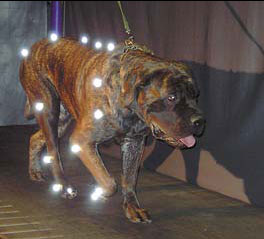Life and Leisure
Walking the dog offers surprising insights
By Andreas Hummel (China Daily)
Updated: 2010-10-15 08:19
 |
Large Medium Small |
The domestic dog may have been man's faithful companion for thousands of years, but a new large-scale study by German zoologists has managed to produce some surprising new results about the animal's movement.
Martin Fischer and his team at Jena University in Germany filmed a total of 327 dogs walking on treadmills with high-speed 3D cameras in order to determine if there are differences across breeds. The results astounded the scientists.
"When we compare the movement of a 2 kg Chihuahua with that of an 80 kg Great Dane, we see that their action is profoundly similar," explains Fischer, who has been studying the movement of animals for over two decades.
Fischer believes the results of the study are so groundbreaking that it will lead to many veterinary textbooks being rewritten.
|
Explaining how dogs move is not only of interest to zoologists, breeders and vets but also engineers. Picture Alliance / DPA |
"The difference between 10 Great Danes is probably greater than the general difference between a Great Dane and a Chihuahua. This means that we can rule out weight having any influence on movement," explains the professor, who heads up the Institute of Systematic Zoology and Evolutionary Biology at Jena University.
"It shows that a breeder can change the size and leg length of a dog but that, even after tens of thousands of years, can't alter the basic characteristics."
Researchers found that the size of a dog's limbs retained the same proportion to the rest of its body regardless of breed or outward appearance.
"It still is not possible after 30,000 years of domestication to vary the size of a dog's upper leg in relation to the limb as a whole," Fischer says. "It's genetically impossible."
Dogs can be bred with shorter or longer legs but the proportions of the limb's individual elements remain the same. The lower legs of miniature breeds, such as Dachshunds, are slightly shorter than usual but only because the joint growth stops earlier.
The scientists also took 50 X-ray images a second of eight breeds of dog to see the movement of the joints.
Fischer hopes the information provided by the images will lead to a paradigm shift in the medical treatment of animals as he is convinced they provide clear evidence of a greater functionality between the shoulder bone and the upper leg than previously thought.
"Veterinary textbooks are going to have to be rewritten," says Fischer.
The research has also shown that, unlike humans, dogs do not achieve their main motion through the movement of joints.
"We have calculated how much of an impact joints have on movement," explains Fischer. Only a third came from the leg joints while two thirds came from the shoulder bone. The findings run contrary to previous thinking.
Explaining how dogs move is not only of interest to zoologists, breeders and vets but also engineers. Another group at Jena University are looking at how dogs that have had a leg amputated compensate for the loss of a limb.
"We can develop different gait patterns in this way," reveals Martin Gross from the college's motion laboratory.
The research is part of a Europe-wide project to better understand locomotion in the hope of developing robots that are better able to overcome obstacles in unfamiliar environments.
DPA
